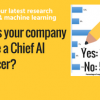Business Transformation Requires Transformational Leaders
Leadership and teaming skills are front and center in times of rapid change. Meet today’s constant disruption head on with expert guidance in leadership, business strategy, transformation, and innovation. Whether the disruption du jour is a digitally-driven upending of traditional business models, the pandemic-driven end to business as usual, or the change-driven challenge of staffing that meets your transformation plans — you’ll be prepared with cutting edge techniques and expert knowledge that enable strategic leadership.
Subscribe to Arthur D. Little's Culture & Leadership Newsletter
Insight
This Advisor examines initial survey findings pertaining to the establishment of dedicated enterprise AI groups and the reason such groups oversee enterprise AI efforts.
Here in Part II, we examine findings pertaining to the establishment of detailed strategies for enterprise adoption and dissemination of AI across the organization, status of “chief AI officers," and budgeting for AI.
The best teams we have worked with know their strength is not the Agile framework alone, but how the team sources ideas and plans and delivers its backlog. Strong team process requires strong team empathy that allows teams to embrace creative tension to uncover novel ways of producing value.
The Gods of Irony Are Smiling
Technology does not reform or change humans. It accelerates and unleashes more of who we are, both good and bad.
Sustainable Cloud Computing: Foundations and Future Directions
In this Executive Update, we devise a conceptual model and practical design guidelines for the holistic management of all resources (e.g., servers, networks, storage, cooling systems) to improve energy efficiency and to reduce the carbon footprints in cloud data centers (CDCs). Furthermore, we discuss the intertwined relationship between energy and reliability for sustainable cloud computing, where we highlight the associated issues. Finally, we propose a set of future areas to investigate in the field and propose further practical developments.
The Data-Agile Approach for Enterprise-Class Data Integration
This Executive Update presents a Data-Agile approach designed to apply most Agile principles to a robust soup-to-nuts spiral data integration methodology that includes all the data management activities crucial for enterprise-class data integration projects.
Working with business leaders, we have developed a simple yet powerful framework to help them navigate the digital landscape. It is based on four business-focused questions that are at the core of effective governance of digital and that every business leader should have in his or her head. We call these questions the four “ares.” In this Advisor, we discuss two of the “ares.”
I’ve come to understand that trust is one of the most fundamental ways that leaders can give their teams space within an Agile transformation effort.















